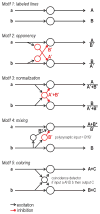Pain processing by spinal microcircuits: afferent combinatorics
- PMID: 22409855
- PMCID: PMC3388176
- DOI: 10.1016/j.conb.2012.02.010
Pain processing by spinal microcircuits: afferent combinatorics
Abstract
Pain, itch, heat, cold, and touch represent different percepts arising from somatosensory input. How stimuli give rise to these percepts has been debated for over a century. Recent work supports the view that primary afferents are highly specialized to transduce and encode specific stimulus modalities. However, cross-modal interactions (e.g. inhibition or exacerbation of pain by touch) support convergence rather than specificity in central circuits. We outline how peripheral specialization together with central convergence could enable spinal microcircuits to combine inputs from distinctly specialized, co-activated afferents and to modulate the output signals thus formed through computations like normalization. These issues will be discussed alongside recent advances in our understanding of microcircuitry in the superficial dorsal horn.
Copyright © 2012 Elsevier Ltd. All rights reserved.
Figures




Similar articles
-
Spinal Circuits Transmitting Mechanical Pain and Itch.Neurosci Bull. 2018 Feb;34(1):186-193. doi: 10.1007/s12264-017-0136-z. Epub 2017 May 8. Neurosci Bull. 2018. PMID: 28484964 Free PMC article. Review.
-
Neuronal circuitry for pain processing in the dorsal horn.Nat Rev Neurosci. 2010 Dec;11(12):823-36. doi: 10.1038/nrn2947. Epub 2010 Nov 11. Nat Rev Neurosci. 2010. PMID: 21068766 Free PMC article. Review.
-
What the brain tells the spinal cord.Pain. 2016 Oct;157(10):2148-2151. doi: 10.1097/j.pain.0000000000000568. Pain. 2016. PMID: 27023423 Review. No abstract available.
-
Spinal Microcircuits and the Regulation of Itch.In: Carstens E, Akiyama T, editors. Itch: Mechanisms and Treatment. Boca Raton (FL): CRC Press/Taylor & Francis; 2014. Chapter 20. In: Carstens E, Akiyama T, editors. Itch: Mechanisms and Treatment. Boca Raton (FL): CRC Press/Taylor & Francis; 2014. Chapter 20. PMID: 24830016 Free Books & Documents. Review.
-
Competition with Primary Sensory Afferents Drives Remodeling of Corticospinal Axons in Mature Spinal Motor Circuits.J Neurosci. 2016 Jan 6;36(1):193-203. doi: 10.1523/JNEUROSCI.3441-15.2016. J Neurosci. 2016. PMID: 26740661 Free PMC article.
Cited by
-
Spinal sensory projection neuron responses to spinal cord stimulation are mediated by circuits beyond gate control.J Neurophysiol. 2015 Jul;114(1):284-300. doi: 10.1152/jn.00147.2015. Epub 2015 May 13. J Neurophysiol. 2015. PMID: 25972582 Free PMC article.
-
Reproducible and fully automated testing of nocifensive behavior in mice.Cell Rep Methods. 2023 Dec 18;3(12):100650. doi: 10.1016/j.crmeth.2023.100650. Epub 2023 Nov 21. Cell Rep Methods. 2023. PMID: 37992707 Free PMC article.
-
Modality-Specific Modulation of Temperature Representations in the Spinal Cord after Injury.J Neurosci. 2021 Sep 29;41(39):8210-8219. doi: 10.1523/JNEUROSCI.1104-21.2021. Epub 2021 Aug 18. J Neurosci. 2021. PMID: 34408066 Free PMC article.
-
Acute inhibition of acid sensing ion channel 1a after spinal cord injury selectively affects excitatory synaptic transmission, but not intrinsic membrane properties, in deep dorsal horn interneurons.PLoS One. 2023 Nov 8;18(11):e0289053. doi: 10.1371/journal.pone.0289053. eCollection 2023. PLoS One. 2023. PMID: 37939057 Free PMC article.
-
Excitatory neurons are more disinhibited than inhibitory neurons by chloride dysregulation in the spinal dorsal horn.Elife. 2019 Nov 19;8:e49753. doi: 10.7554/eLife.49753. Elife. 2019. PMID: 31742556 Free PMC article.
References
-
- Baxter DW, Olszewski J. Congenital universal insensitivity to pain. Brain. 1960;83:381–393. - PubMed
-
- Merskey H, Bogduk N. Classification of Chronic Pain. Seattle: IASP Press; 1994.
-
- Maier C, Baron R, Tolle TR, Binder A, Birbaumer N, Birklein F, Gierthmuhlen J, Flor H, Geber C, Huge V, et al. Quantitative sensory testing in the German Research Network on Neuropathic Pain (DFNS): somatosensory abnormalities in 1236 patients with different neuropathic pain syndromes. Pain. 2010;150:439–450. - PubMed
-
- Melzack R, Wall PD. Pain mechanisms: a new theory. Science. 1965;150:971–979. - PubMed
-
- Green BG. Temperature perception and nociception. J Neurobiol. 2004;61:13–29. - PubMed
Publication types
MeSH terms
Grants and funding
LinkOut - more resources
Full Text Sources
Medical
Research Materials

